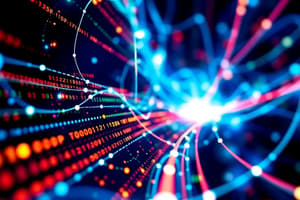Podcast
Questions and Answers
What is the role of network protocols in a computer network?
What is the role of network protocols in a computer network?
- Displaying graphical user interfaces
- Providing power to the devices
- Facilitating communication between different devices (correct)
- Storing large amounts of data
Which networking protocol is widely used for local area networks (LANs)?
Which networking protocol is widely used for local area networks (LANs)?
- Bluetooth
- Wi-Fi
- TCP/IP
- Ethernet (correct)
What does TCP/IP define in the context of computer networks?
What does TCP/IP define in the context of computer networks?
- The shape of network devices
- How to transfer data over the internet (correct)
- Physical layer details like cable types and connectors
- The color of cables used in networks
Which technology helps different devices find and talk to each other wirelessly?
Which technology helps different devices find and talk to each other wirelessly?
What do protocols define in the context of device-to-device communication?
What do protocols define in the context of device-to-device communication?
What is the primary function of routers in a computer network?
What is the primary function of routers in a computer network?
Which component of data transmission involves converting data into electrical impulses for network transmission?
Which component of data transmission involves converting data into electrical impulses for network transmission?
In a bus topology network, how are all devices connected?
In a bus topology network, how are all devices connected?
In a computer network, what are switches primarily responsible for?
In a computer network, what are switches primarily responsible for?
What is a disadvantage of the star topology network layout?
What is a disadvantage of the star topology network layout?
Which topology allows multiple tiers of branches and is good for larger systems' organization?
Which topology allows multiple tiers of branches and is good for larger systems' organization?
What component does decoding play in the data transmission process?
What component does decoding play in the data transmission process?
Flashcards are hidden until you start studying
Study Notes
Computer Networks Overview
A computer network is more than just connecting devices together; it's the infrastructure of our digital world. It enables communication between computers, allowing them to share information and resources. At its core, a network consists of hardware components like routers, switches, cables, hubs, and wireless access points, which work together to enable data transport across various media such as copper wires, fiber optic lines, radio waves, and even light pulses through free space. But what makes the magic happen? Let's delve into three key concepts: network protocols, data transmission, and network topologies.
Protocols: The Language of Computers
Network protocols act as languages that allow different devices to communicate with each other over the network. There are several well-known networking protocols:
-
TCP/IP: This suite of Internet standards defines how to transfer data from one device to another via the internet. It handles everything from addressing devices to routing packets of information across networks.
-
Ethernet: A widely used local area network (LAN) technology based on the IEEE standard. It specifies physical layer details, including cable types and connectors, along with frame formatting rules for a shared medium network.
-
Wi-Fi: Known formally as Wireless Fidelity, this family of standards helps different devices find and talk to each other wirelessly.
Protocols define both the structure of messages sent from device to device and the error checking methods used by those messages. They ensure accurate delivery of data despite errors introduced during transit. Without these protocols, communication across networks would resemble a game of telephone where original meaning could get lost.
Data Transmission: How Information Moves Across the Network
Data transmission involves moving bits of information—ones and zeroes—from their source to their destination using signals over a network connection. Signals can travel over copper cables or fiber optic lines, while radio waves are used for wireless connections. The actual process of transmitting data has two main components:
-
Encoding: Converts data from its stored format into a set of electrical impulses or signals that can be transmitted across the network.
-
Decoding: At the receiving end, converts the received signals back into readable data.
To send data effectively, sources need to agree upon signal characteristics like voltage levels, frequency range, etc., so receivers know what constitutes a 'one' versus a 'zero', thus understanding the message being sent.
Topology: Structuring the Network Layout
The layout or design of a network determines how computers are connected to each other. Different network topologies have varying advantages and disadvantages when it comes to cost, speed, reliability, flexibility, and scalability. Common topologies are:
-
Bus Topology: All devices are attached to a single line or bus. Each packet travels the length of the bus before reaching its intended recipient. While simple, this setup doesn't handle collisions very well.
-
Star Topology: Every device is directly linked to a central node called a switch or a hub. If any link breaks, only the affected devices lose communication until fixed. However, replacing faulty equipment requires shutting down parts of the network.
-
Ring Topology: Devices are arranged in a closed loop configuration. Packets pass around the ring, traveling to every machine on the path before returning to the sender. Efficiency decreases if there are many nodes or heavy traffic.
-
Tree Topology: Similar to star topology but allows multiple tiers of branches, enabling better organization within larger systems.
Choosing the right topology depends on factors like geographical spread, size of the organization, expected growth, and available budget.
In summary, computer networks consist of complex interactions among hardware devices, utilizing specific protocols for correct interpretation of data, and employing appropriate topological designs based on requirements. Understanding these fundamental aspects ensures effective communication over networks, making the invisible web visible and accessible to users worldwide.
Studying That Suits You
Use AI to generate personalized quizzes and flashcards to suit your learning preferences.




